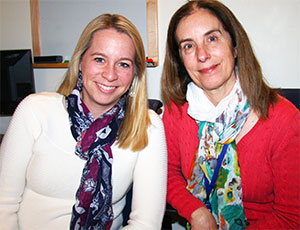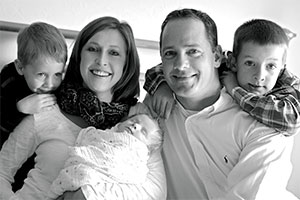Long Distance Relationships
Telemedicine Initiative Delivers Patient Care Closer to Home
By Tyler Smith
 (May 2014) Tight physician-patient bonds are generally a good thing. But a growing number of providers have found that long-distance relationships can be the most
(May 2014) Tight physician-patient bonds are generally a good thing. But a growing number of providers have found that long-distance relationships can be the most
The Colorado Fetal Care Center at the Colorado Institute for
The approach allows specialists to detect and monitor fetal abnormalities at regular intervals while sparing patients long trips to get the imaging procedures, says Bettina Cuneo, MD, visiting
“Where you live shouldn’t define the level of health care you receive,” Cuneo says. “With telemedicine, we can make sure that women who live in remote areas have the same access to care as those who live near major medical centers.”
Shrinking distances
Cuneo, who set up a telemedicine program with Advocate Hope Children’s Hospital in Chicago, is leading a similar effort with the CIMFH.
She is looking for opportunities at hospitals in Colorado, Wyoming, New Mexico, Idaho and Montana
Aside from saving mothers the time, expense, and physical and emotional discomfort of travel, telemedicine can help specialists identify fetal cardiac
The earlier a diagnosis is made, the longer
“Most babies with heart disease, for example, do not get into trouble until they are born,” she says. “At the time of birth, we strive to make sure that they are in the right place, with the right diagnosis.”
An earlier diagnosis also decreases the risk of a premature delivery, which often means an additional set of medical problems. For example, Howley explains, providers often can manage a slow fetal heart rate, which can be a sign of distress, without having to deliver the baby.
“A lot can be done in utero without having to also deal with the risks of prematurity,” Howley says.
Cardiac crisis
 A telemedicine option would have benefited Erin and Zane Luttrell of Montrose, whose son Caleb was born Oct. 18 of last year. Erin, 34, was 20 weeks pregnant when her community obstetrician discovered that Caleb’s fetal heart rate was 55 beats per minute. Normal is 140. The couple traveled to Grand Junction to consult a high-risk obstetrician who performed an ultrasound that revealed a heart block that was disrupting the electrical signals traveling from the upper chambers of Caleb’s heart (the atrium) to the lower chambers (the ventricles).
A telemedicine option would have benefited Erin and Zane Luttrell of Montrose, whose son Caleb was born Oct. 18 of last year. Erin, 34, was 20 weeks pregnant when her community obstetrician discovered that Caleb’s fetal heart rate was 55 beats per minute. Normal is 140. The couple traveled to Grand Junction to consult a high-risk obstetrician who performed an ultrasound that revealed a heart block that was disrupting the electrical signals traveling from the upper chambers of Caleb’s heart (the atrium) to the lower chambers (the ventricles).
The Grand Junction obstetrician referred the Luttrells to Howley to monitor the fetus in utero. The condition demanded close attention.
“The fetus struggled to maintain the cardiac output of an average heart,” says Howley, who prescribed for Erin medications that crossed the placenta and increased Caleb’s in utero heart rate, but only to 62 beats per minute.
Howley’s most challenging recommendation, however, was that Erin return to Children’s Colorado once a week so Howley could monitor Caleb’s heart function. That meant a six-hour drive or a flight to the Denver area, which was further complicated by the need to make sure there was care for the couple’s two other children, Cole, 7, and Conner, 4.
Beginning in July, Erin, accompanied by either Zane or her mother, made weekly trips to Aurora. She typically rented an apartment near the Anschutz Medical Campus, stayed overnight and saw Howley and CU Maternal Fetal Medicine Section Chief Henry Galan, MD, professor of obstetrics and gynecology.
Toward the end of September, Erin and Zane moved to Aurora and remained there until the October delivery, which took place by C-section two weeks earlier than planned because Caleb’s heart rate had gotten dangerously low. He arrived at 6 pounds, 3 ounces, was sent to the Cardiac Intensive Care Unit and received a pacemaker three days later. He is home in Montrose now, his incision healing and his heart rate continuing to increase, Erin says.
Luttrells praised Howley and Galan for their close attention to detail and emphasis on explaining Caleb’s condition, how it would be treated and what they could expect during and after delivery. “We couldn’t have asked for better care,” Erin says.
Dangerous distance
 But they also admit the expense and time demands of travel compounded an already stressful situation — one that could have been worse, Zane adds.
But they also admit the expense and time demands of travel compounded an already stressful situation — one that could have been worse, Zane adds.
"We had a support system at home with Erin’s parents, aunts and uncles,” he says. The couple owns their own sand-and-gravel business, and their “employees stepped up. Without that, it would have been very difficult to be gone,” Zane adds. “We felt fortunate. There were families at Children’s who had been there longer than us.”
“Telemedicine would have helped,” Erin says. “We were under stress because we were in a situation where we didn’t know if our child was going to make it. It would have been different if we’d been able to stay here [at home].”
“The better your ability is to get cutting-edge technology and access to experts, the better you will be able to get great medical care,” Zane adds.
Remote possibilities
Cuneo aims to make that happen in Colorado and the region. While at Advocate Hope Children’s Hospital she built telemedicine partnerships with Sherman Hospital in Elgin, Ill., and with hospitals in Joliet and Hammond, Ind. She held “virtual clinics” several days a week for fetal echocardiograms, and was available to consult with the obstetricians at the hospitals if they had a fetal cardiac problem that couldn’t wait for the regularly scheduled clinic.
Two-way video inputs connected her Chicago office to the remote clinic, where she interacted in real time with a mother, obstetrician and sonog-rapher. Cuneo took a history from the mother and explained the test to her before the camera switched to the echo machine, allowing Cuneo to look at the fetal images.
“It’s like standing over the shoulder of the sonographer,” Cuneo says. The audio on the system in Chicago was so good, she says, that the crunch of a bite from an apple while she worked could be disturbing. As she watched, Cuneo directed the sonographer to change the scale or position of the view, or to zoom in or out.
Cuneo examined the images live. If she detected an abnormality — a serious arrhythmia or structural cardiac defect for exampl — she made it her “personal credo” to see the patient face-to-face within 24 hours. She also discussed how to manage the abnormality with the mother’s obstetrician.
Telemedicine could help close a troubling fetal care gap in Colorado, Cuneo says. In Illinois, 80 percent of fetal abnormalities are detected before birth. The percentage in Colorado, she says, is half that.
Cuneo has been doing the legwork to close that gap since coming to Children’s Colorado last September, in part for a chance to work with Colorado Fetal Care Center Director Timothy Crombleholme, MD, MA, professor of surgery and a pioneer in fetal surgery. Most of her work, Cuneo says, has been “meet-and-greets” with obstetricians, some of whom express surprise that pediatric cardiologists image the fetal heart.
“Getting buy-in from the OBs, who will be the ones referring their patients, is crucial,” she says. With that, setup requires a video system with two inputs, computer screens, a dedicated DSL or T1 line, and a well-trained sonographer who has practice working with a perinatal cardiologist. She estimates the hardware for remote technology can pay for itself with 10 to 20 echocardiographies, while line charges, although minimal, are ongoing.
More importantly, telemedicine can extend the continuity of maternal fetal care, Cuneo adds. “It can provide a bridge from the fetus to the neonate. Patient care doesn’t start at birth.”
This article first appeared in the UCH Insider, the University of Colorado newsletter.